A lake in Central America is the latest focus in the International Continental Scientific Drilling Program. The ICDP is a multinational program to promote and coordinate continental drilling projects with global significance.
Researchers with the Lake Petén Itzá Scientific Drilling Project (PISDP) are currently drilling and collecting continuous sediment cores in waters 30-150 m deep. Petén Itzá is the deepest lake in the Yucatan Peninsula, southwest of Tikal National Park in the dense rainforest of the Petén region in northern Guatemala.
The team is drilling and coring with the GLAD800 system, maintained by Salt Lake City-based DOSECC (drilling, observation, and sampling of the Earth’s continental crust) and the ICDP.
Eight principal investigators on the project represent five institutions, including the University of Florida, ETH-Zurich, University of Geneva, Carnegie Institution, and GeoForschungsZentrum Potsdam (GFZ).
In addition, graduate and postdoctoral students from the University of Florida, ETH, and Germany’s Technische Universität Braunschweig are part of the field crew, trained to use the drilling information system developed by GFZ for field labs and virtual global lab networks.
Field work
The PISDP drilling and science teams established a field laboratory in El Remate at the eastern end of the lake in mid-January. Drilling in Lake Petén Itzá began Feb. 3 and will finish by mid-March, according to Prof. David Hodell, University of Florida.
The GLAD800 (global lake drilling 800 m) system is also known as the R/V Kerry Kelts. It includes a modified Christensen CS-1500 diamond-coring rig supported by a 80x24-ft “superbarge.” The platform is a 3-2-3-3 arrangement of watertight shipping containers, with the space for the missing container providing a moonpool. The containers are sealed, with air bladders and styrofoam inside for flotation, then pinned and spot-welded to form the barge. The platform has a four-point anchoring system and can be towed at 3 km/hr.
Based on data from two seismic surveys, researchers selected six primary drillsites and four alternates. Hodell said they are coring three holes, 5-10 m apart, at each drillsite to ensure they recover a complete stratigraphic section. PISDP is using three sets of coring apparatus: hydraulic piston coring; an extended core barrel (15-cm-long, nonrotating extension below bit); and “the Alien,” a conventional rotary tool used at the end of each borehole to sample the last sediments and bedrock.
Drilling is predominantly with water, although the PISDP team has used some polymer and bentonite to get through a 10-m layer of coarse-grained gypsum sand.
The 6-cm diameter cores are sent to the shore base in capped liners, where Hodell says they are being kept at 4° C. in a container that will be shipped to the University of Minnesota. The cores will be split and imaged; half will be archived in the US and the other half used for discrete sampling and testing such as radiocarbon and Ur/Th dating.
A team from Potsdam is using slimhole tools for wireline logging: natural and spectral gamma ray through drill pipe; sonic, magnetic susceptibility, resistivity, and borehole televiewer in open hole.
At the Guatemala field lab, the team is squeezing pore water samples, testing for alkalinity, and preparing and describing smear slides using sediment samples from the core catcher.
The cores will provide “long continuous lacustrine archives” of sediment and pore waters to test hypotheses related to three scientific themes:
• Paleoclimatic history of the lowland Neotropics.
• Paleoecology and biogeography of the Maya tropical lowland forest.
• Biogeochemical cycling in deep lake sediments (geomicrobiology).
Hurdles
Researchers faced several hurdles before drilling could begin. Hodell said importing the equipment under a temporary permit was a slow process, and particularly so during the December-January holiday period.
Equipment also broke down. The boat being used to move the drilling platform and for crew transfers lost its motor at the end of the first borehole, but the team was able to get a replacement boat from a nearby hotel.
Hodell said the prevalence of tarantulas at the shore base is an annoyance but has not significantly affected operations. Although they’re “all over the place,” they only come out at night.✦


